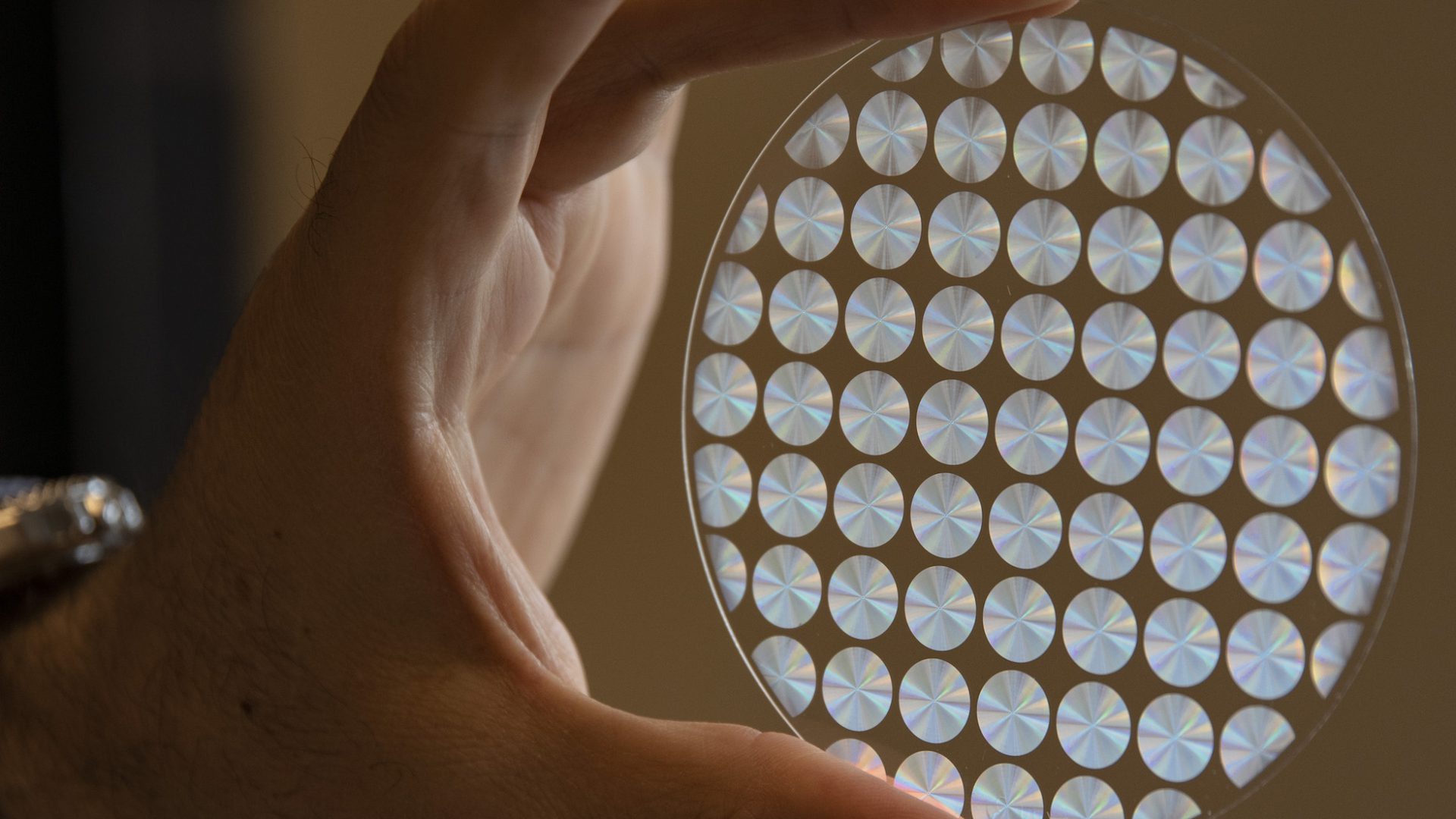Developing Platforms for Advanced Biosensing
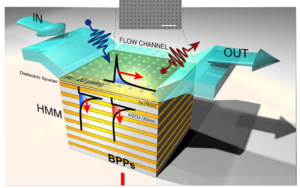
This project aims to develop novel biosensor platforms that will outperform standard detection techniques in both sensitivity and read-out time. Sensing is important in a wide variety of fields, including medical diagnosis, chemical and biological analysis, health and safety, and environmental testing. This process in enabled by harnessing exotic metamaterial properties to engineer high sensitivity modes, which can be integrated into optical sensor technologies.
For example, more than half a million Americans die from cancer every year. High-throughput screening will play a critical role in making continued progress on survival rates and quality of life. Ultrasensitive devices that can detect low-concentration biomarkers can identify the onset of cancers. Such biosensors can also be used to track other aspects of the treatment regimen, including the effectiveness of clinical interventions, such as immunotherapies. We have developed such an ultrasensitive platform by combining hyperbolic metamaterials (HMMs) and aptamers as high-specificity, high-affinity recognition molecules that can be custom designed for a wide variety of possible biomarkers. The great potential of HMMs has been dramatically illustrated in a recent publication in Nature Materials.
In another example, biomolecular recognition of genetic fragments and proteins is a promising diagnostic protocol for cancer and infectious diseases. These technologies could be used to drastically improve the sensitivity to specific biomarkers, developing a new generation of high-throughput, extreme-sensitivity, tailorable specificity, and intrinsically scalable health technologies. We have shown how combining chiral metasurfaces and hyperbolic metamaterials can enable both high sensitivity and specificity for low-molecular-weight nucleic acids and proteins. Specificity was achieved by a receptor-ligand interaction at the sensing surface. This work was illustrated in a recent publication in ACS Applied Material Interfaces.
References:
- (2016) Nature Materials, 15, 621-627, “Extreme sensitivity biosensing platform based on hyperbolic metamaterials”
- (2016) Adv. Opt. Mat., 4, 11, ‘Enhancing the Angular Sensitivity of Plasmonic Sensors Using Hyperbolic Metamaterials’
- (2017) EPJ-AM, 4,1, “Hyperbolic metamaterials-based plasmonic biosensor for fluid biopsy with single molecule sensitivity”
Nanotechnologies at the Interface of Physics and Medicine
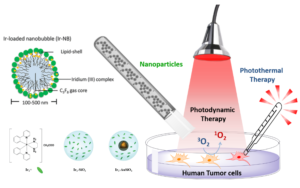
This project aims to develop novel therapies to improve treatment capabilities for a range of human diseases, including cancers. This process is enabled by utilizing and expanding upon the optical properties of nanoscale materials such as the visible range localized surface plasmon resonance in metallic nanoparticles, and the singlet oxygen production of Ir(III) nanostructures. Such treatments can potentially be employed to destroy cancer cells from the inside, without the harmful side effects of current immunological therapies.
For example, we have designed a platform for photodynamic and photothermal therapies by embedding a purposely synthesized iridium(III) compound into gold core–silica shell nanoparticles. The photophysical properties of the Ir complex consist of: (1) the generation of cytotoxic reactive oxygen species (singlet oxygen, 1O2), which induce irreversible damage to tumor cells; (2) the plasmonic resonance of gold nanostructures which can induce photothermal damage. We have shown significant cancer cell death at a very low photosensitizer concentration. This work is highlighted in a recent publication in Nanoscale.
In another example, a sonodynamic therapy was developed as a minimally invasive cancer treatment derived from photodynamic therapy. This technology is enabled by loading iridium(III) complex into echogenic nanobubbles. The nanobubble system is then acoustically activated by low-frequency ultrasound resulting in a localized therapeutic effect attributed to the generation of reactive oxygen species. Through a combination of sonication and the nanobubble treatment, an increase of 68.8% and 69.6% cytotoxicity in human ovarian cancer cells (OVCAR-3) and human breast cancer cells (MCF-7), respectively, was observed, demonstrating promise as a future cancer therapy. This work was illustrated in a recent publication in Bioconjugate Chemistry.
References
- Interface of Physics and Biology Bioconj. Chem. 26, 51−62 (2015)
- Plasmon Mediated Cancer Phototherapy Nanoscale DOI: 10.1039/c7nr05522f (2017)
- “Extreme sensitivity biosensing platform based on hyperbolic metamaterials” (2016) NATURE MATERIALS, 15, 621-627,
- Photonics and plasmonics go viral: self-assembly of hierarchical metamaterials” REND. FIS. ACC. LINCEI (2015)
Plasmonic and Photonic Materials
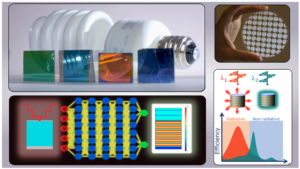
This project aims to create interesting applications driven photonic and plasmonic materials by engineering specific photonic interactions at the nanoscale. This category includes: metamaterials and metasurfaces, plasmonic materials, hyperbolic metamaterials, epsilon-near-zero (or near-zero-index) metamaterials, Fano-resonant materials, and general optical coatings. In particular, we are interested in materials with plasmonic modes. This process is enabled by developing next-generation design tools, such as machine learning for photonic design, and utilizing cutting-edge fabrication techniques both in-house and with a diverse array of collaborators.
For example, metasurface technology (including metalenses, or ‘flat lenses’) is currently limited by the prevalence of static devices. We have recently employed liquid crystals to enable reconfigurability in optical metalenses, allowing the lens to dynamically change its focusing properties post-fabrication. We show numerically and theoretically that the focal length of the lens can be modified by affecting the refractive index of a liquid crystal infiltrate, which can be controlled via external stimuli. In particular, we control the refractive index of the liquid crystal by crossing the nematic-isotropic transition, leading to a substantial shift in the focal length. This work was partially illustrated in a recent publication in Proceedings of the National Academy of the Sciences (PNAS).
In another example, we have investigated the optical force produced by the interaction between nanoparticles and a metasurface interface. The produced forces are due to the interfering electric field profile and can be used to ‘levitate’ nanoscopic matter above the surface, producing either attractive (pulling to the surface) or repulsive (pushing away from the surface) forces depending on the metasurface properties. Utilizing epsilon-near-zero (ENZ) materials, this effect is reminiscent of the Meissner effect in superconductor physics. This work was recently illustrated in an Arxiv preprint.
References:
- “All-Optical tunability of metalenses permeated with liquid crystals” ACS Nano (2022)
- “Epsilon-Near-Zero (ENZ)-based Optomechanics“ arXiv (2022)
- “Fano-resonant ultrathin film optical coatings” Nature Nanotech. (2021)
- “General inverse design of thin-film metamaterials with convolutional neural networks” ACS Photonics (2021)
- “Hyperbolic meta-antennas enable full control of scattering and absorption of light” Nano Letters (2019)
Exploring Plasmon-Excition Interactions in Nanophotonics
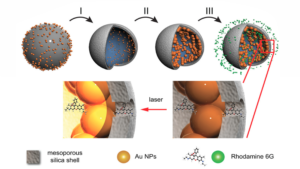
This projects aims to investigate and develop a radically new generation of nanostructured plasmonic materials, created for infrared and optical frequencies. These materials are based on the use of nano-chemistry and self-assembly of soft materials as an alternative to standard lithography or multi-beam holography. This fabricating and assembling route is highly innovative by being tightly focused on the gain-plasmon interplay. In particular, we demonstrate that gain-plasmon dynamics in metallo-dielectric nanostructures play a specific role to create non-traditional materials spanning from loss compensated optical metamaterials to plasmon nanolasers. Extraordinary plasmonic properties arise by an atomic control and positioning of single nano-structured elements (fluorophores and plasmonic nanoparticles) via a multi-pronged bottom-up approach that will push research frontiers in opto-plasmonic applications.
References:
- “Tunable black gold: controlling the near‐field coupling of immobilized au nanoparticles embedded in mesoporous silica capsules” Advanced Optical Materials (2017)
- “Loss-mitigated collective resonances in gain-assisted plasmonic mesocapsules” ACS Photoncis (2014)
Lasing in Soft Materials and Nanoparticle Dispersions
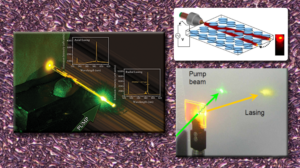
This project centers around the creation of laser action in disordered (‘random’) media, as well as the properties of nanoparticles dispersed in soft matter, including liquid crystals and polymers. Random lasing is distinct from typical laser implementations in that the path length of the excited light is not fixed by an external resonant cavity. Rather, the resonant cavity is a product of multiple scattering in the disordered media. The mirrorless design allows these systems to be minaturized beyond traditional lasers. One of the most interesting aspects of these lasing systems is related to the possibility to modify the spatial periodicity characterizing the confining optical cavity by varying external parameters (temperature, electric field, mechanical stress, optical field, etc.), thus tuning the laser emission. These systems open a completely new challenging research field with thrilling perspectives for scientific and technological purposes.
We have been involved in creating and studying novel photonic band-gap microstructures which give rise to color tunable, DFB micro-cavity lasers with a high ratio between the quality factor Q of the cavity and its volume V, usually referred to as the Purcell-number. The optical micro-cavities were obtained by embedding dye-doped helixed liquid crystals in holographically patterned polymeric micro-channels. In this way, each micro-channel becomes an optical mirror-less microcavity with a very small volume V of only a few cubic micrometers, resulting in a remarkable Purcell-number (highly desirable).
Electro-hydrodynamic instabilities and turbulence in liquid crystals are also representing an unparalleled scientific arena to investigate the interesting physics behind the chaotic lasing. The background in the image above shows the electro-hydrodynamic Williams domain in nematic MBBA doped with PM597 laser dye, driven by an AC electric field.
References:
- “Manipulating Random Lasing Correlations in Doped Liquid Crystals” arXiv (2022)
- “Beaming random lasers with soliton control” Nature Communications (2018)
- “POLICRYPS: a liquid crystal composed nano/microstructure with a wide range of optical and electro-optical applications” Jornal of Optics A (2009)
- “Anisotropy of spatiotemporal decorrelation in electrohydrodynamic turbulence” Phys. Rev. Lett. (2011)

